By Travis Knoll

In the past year, the fragile affirmative action policies in the United States have come under withering attack, culminating in recent weeks with the Trump administration’s reversal of the Obama administration’s interpretation of affirmative action policy. While U.S. proponents plead the public case for diversity anew, halfway across the world, Brazilian activists reacting to the news warned Brazil’s government against taking similar steps to dismantle a much stronger racial-based affirmative action in their country. They will likely succeed because of resounding legislative and constitutional support for vigorous quota and financial aid policies in that country. This broad consensus in a country with its own struggles with race provides a model for surviving a gutting of affirmative action precedents and shows a path to building new coalitions in support of effective affirmative action policies.
While Brazil’s affirmative action policies enjoy broad legal support, the policies’ fate in the U.S. waxes and wanes. In the wake of new discrimination accusations by Asian-American students against leading U.S. institutions’ use of race in admissions, the Trump administration, like George W. Bush administration before it, issued guidance discouraging use of race as a factor in elementary, high school, and university admissions.

In Brazil, affirmative action activists are unfazed by the developments to the north. Friar David Raimundo dos Santos, the leader of one of Brazil’s first college prep courses specifically for racially and socioeconomically marginalized Brazilians spoke a day after the issuing of the new guidance. He recently reminded Estado de São Paulo, a leading Brazilian newspaper, that the debate over affirmative action in Brazil “was not even close” and that opponents would need to change Brazil’s constitution to reverse the policies.
Doing so would be an uphill climb. Affirmative action in Brazil stands on the foundation of two separate laws implementing quotas in public university admissions and in the public sector. Race-based quotas for public universities were declared constitutional by Brazil’s Supreme Court in 2012 and for the public sector in 2017. Meanwhile, socioeconomic quotas as a whole enjoy continued majority support in Brazil.
Middle-class Brazilians often admire the U.S. legal system and Brazilian judges often cite U.S. affirmative action precedents in their decisions on the matter. Because of this, friar David has warned that affirmative action opponents may use the recent U.S. decision to try to turn middle-class Brazilians against such policies. Those forces will have media confusion to thank. Some newspapers, such as center-right Estado de Minas and the left-leaning blog Revista Forum, have conflated Brazilian and U.S. affirmative action policy. They report that Trump has reversed the use of racial quotas, which Brazil employs in university admissions, when the U.S. has longed banned quotas and employs a far milder, holistic process.
The U.S. Supreme Court has expressly prohibited use of racial quotas by U.S. universities since the court’s 1978 Bakke decision. The Supreme Court’s Grutter vs. Bollinger and Gratz et. al. vs. Bollinger (2003) decisions both upheld “holistic” admissions policies and struck down policies that gave across-the-board raced-based boosts to college admissions applications. The court confirmed this reasoning in 2016 in Fischer vs. University of Texas.
In Brazil, constitutional provisions mandating equality and due process call explicitly for equal opportunity, not just protection from racism. This constitutional clarity combined with Brazilian public institutions’ multi-layered quota system (including widely accepted socioeconomic and gender quotas) make the policy palatable even to conservative Brazilian justices.
The quotas are also effective. According to affirmative action expert Rosana Heringer, quota policies approved by local university councils, targeted national financial aid programs, and the expansion of universities into more isolated regions, helped increase brown and black Brazilian university higher education attendance five-fold between 1997 and 2011. According to Ministry of Education data (summarized by the Cost of Opportunity project here), from 2003 to 2014 the percentage of university students identifying as black and brown at federal universities rose from 34 percent to 48 percent of all students. Students earning less than 2 times Brazil’s minimum wage rose from 26 percent to 37 percent of all students.
With a more conservative court, the U.S. remains unlikely to implement quotas or any other affirmative action policy as far-reaching as Brazil’s. Brazil’s policies did not come into being overnight, however, but through years of struggle and constant explanations of the potential benefits. In fact, the gains cited above occurred before the courts and the legislatures approved affirmative action and while the Brazilian public remained conflicted on the university quota. In 2008 respondents deemed racial quotas “humiliating” for blacks but general quotas “necessary” for institutional diversity by margins of 53 and 62 percent respectively. Overall, only 51 percent of Brazilians supported racial quotas, with 62 percent of Brazilians believing that quotas would exacerbate racial tensions.
Higher education institutions wishing to adapt to tighter affirmative action restrictions can implement substitute policies for the more direct controversial ones. The courts may end traditional affirmative action admission policies, but universities in the U.S. need to follow their Brazilian peers’ example and take the leading role developing innovative diversity workarounds when the government proves absent or hostile.
For instance, U.S. universities could create and highlight initiatives such as free online and in-person pre-college prep courses to prepare economically and racially disadvantaged groups before they even start filling out applications. Universities need to allocate even more money for financial aid and earmark it for diverse populations. They could adopt quota factors such as domestic physical geography and the applicant school’s ranking as proxies for diversity. Recent developments require universities to communicate effectively, stubbornly put affirmative action at the front of their agendas. If universities show the willingness to boldly embrace affirmative action even in the midst of legal uncertainty, the US public, like Brazil’s, may eventually follow their lead.
